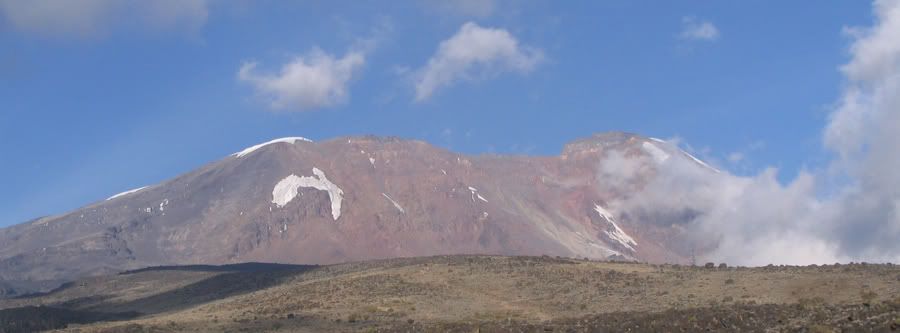My Take on Cloverfield, Part 2. **SPOILER ALERT**
 The image is an actual warning posted at a ticket booth. I decided this image was relevant to the continued discussion of Cloverfield because it exploits a side effect of both the medium and shooting technique used to record the film. Now I love DV (or Digital Video) medium and use it myself on many occasions because it's cheap and because of its raw, "happening right now" feel. It's as though you are looking at documented footage en lieu of fine cinema quality. I love the low light grainy effects it makes as well. I think more films should be shot in this format because it is really versatile. True, some cinema-phile types will scoff at the thought but then again I am not a true cinema-phile. I just love movies big budget, little budget, large or small and all points in between. But this instance, coupled with the fact that no Steady-cam was used (to add more realism to the scenes where the characters are fleeing the impending attack and under direct attack), does make Cloverfield a real concern for those who suffer from motion sickness!
The image is an actual warning posted at a ticket booth. I decided this image was relevant to the continued discussion of Cloverfield because it exploits a side effect of both the medium and shooting technique used to record the film. Now I love DV (or Digital Video) medium and use it myself on many occasions because it's cheap and because of its raw, "happening right now" feel. It's as though you are looking at documented footage en lieu of fine cinema quality. I love the low light grainy effects it makes as well. I think more films should be shot in this format because it is really versatile. True, some cinema-phile types will scoff at the thought but then again I am not a true cinema-phile. I just love movies big budget, little budget, large or small and all points in between. But this instance, coupled with the fact that no Steady-cam was used (to add more realism to the scenes where the characters are fleeing the impending attack and under direct attack), does make Cloverfield a real concern for those who suffer from motion sickness!
Some will recall the movie "The Perfect Storm" starring Mark Wahlberg, George Clooney and Diane Lane among others about a commercial fishing crew trying to score a major catch of the season (worth beaucoup bucks) that decide to brave stormy waters in order to get back home before their booty starts to spoil. They end up hitting the gnarliest of all storms and the crew end up all perishing. The only reason I mention the film is that a friend of mine and I went to see it when it first cam out and got stuck sitting rather close to the big screen. Because most of the film took place out in the ocean the entire screen was often a flow mass of water and the scenes were always in a perpetual state of motion. Being so close to the screen one's peripheral vision loses its ability to maintain an outer (non-moving) frame of reference. So in essence, your mind is tricked into thinking, due to the data received from your visual field, that it is in motion when in fact your are sitting stationary. Neat bit of science but not so neat for sufferers of motion sickness like my friend who had to sit out in his car for the last hour of the film while I watched on.
Not to get off the subject of Cloverfield, but it is important to note that this is a real concern since again, two members of my viewing party for Cloverfield did mention they had slight headaches as we were leaving the theater. So suffice to say, while you have probably experienced poor quality footage on sites like You Tube/Google Video or MySpace Video, the level of shaking in Cloverfield is taken to the exponential level. After all, even though most people are not professionals, they still try shoot decent video with as minimal shaking as possible. But when filming Cloverfield the footage was left shaking like crazy ON PURPOSE and I bet here and there it was even made worse for a realistic effect. So be cognizant of that fact heading into the theater.
With that said, Cloverfield offers an experience closely akin to The Blair Witch Project only in Cloverfield the characters actually turn around (earth shattering, right?) to see what the hell they are running from. They are running from a real ferocious monster. Plus, this monster packs a double punch. All the while its laying waste the great borough of Manhattan it's shedding these little parasitic nasties that run after people (but not animals, still don't know why) and slice and dice them faster than Martin Yan can de-bone a chicken. Here is where I pick up from Part 1 because the overall theme of Cloverfield, in my opinion, can be summed up in the following sentence:
"What the fuck?"
As we approach what we sense might be a climax (yet again the pace of the film really doesn't afford this) as our remaining cast are trying to get to Beth in time to make it off the island together, we are confronted with yet more unanswered questions. There is a scene where our group make it to the neighborhood where Beth's apartment is. Of course, they are confronted with a daunting image of her apartment building leaning against a neighboring high rise. As is the case throughout the whole movie, no task is ever marginally difficult, instead it is seemingly impossibly dangerous. But what the hell, right? Might as well risk your lives in the leaning apartment building rather than face the impending doom of the monster and its little friends! But before they set sight on the leaning apartment they are greeted by a Clydesdale pulling an empty carriage. As mentioned previously, you'd think the horse would have been picked clean by the parasites, but no and we have no idea why.
In typical storybook fashion, the troop manage to make their way up the adjacent building in order to rescue Beth. You really had a sense this was going to happen because for every challenge or sticky situation in Cloverfield, as long as you got past it there was a reward of sorts. Of course, the fact that Marlena is infected with an unknown bug resulting from the parasite bite is bittersweet not only because she had saved Hud when they were attacked in the tunnel BUT ultimately we don't know what the &@%! the illness is. We're only given an image of her bleeding from the eyes, nose and ears and what appears (from behind the quarantine curtain) to be her torso exploding. I know I'm sounding like a I'm beating a dead horse but please, throw us a bone, man!
I will not get bogged down in the chaos and disappointment that the abrupt ending presented, other than saying that Cloverfield is indeed an intense ride but one that will leave most craving answers that can only be answered in a sequel. To me this is a good idea, cause only a short time into the movie, I had the sense that this was actually a giant prequel to something bigger. One thing I have to add, in all due respect, since it might seem like I have been beating this movie up a bit, is that I did appreciate the little window into the story that happened at the very, very end of what must be considered archival footage (because everyone in the core cast is assumed dead by the audience at this point). The footage shows a beach scene at Coney Island, N.Y. where you see the boardwalk, carnival games and the ocean. Off in the distance as you hear Rob and Beth chit-chat you can see something rather large plunge into the ocean a few miles offshore. What is it? We don't know. But it might be the answer to the question of where the creature actually came from in the first place.
According to the Wiki page, J.J. Abrams is quoted as saying the object that hits the water offshore is a crashed satellite owned by the Tagruato company that awakens the beast which was lying dormant in the ocean for thousands of years. However, when you follow the citation provided it merely directs to a fan site and nothing officially from Abrams himself. Plus, this would lead one to ask, "What caused the satellite to crash?" Why would the beast in fact, having been disturbed by the crashing satellite, be motivated to sack the Tagruato offshore drilling station. There is no sign of the station in the Coney Island footage? I could see if the monster's original sleeping location and Manhattan formed a bee line right through the drilling station, then it would make sense for it to be attacked. Yet more questions from a movie that will no doubt have much buzz surrounding it for some time.
And just a side note, I know not many of you reading this review would have had a chance to actually see the Statue of Liberty or had the chance to look out of her crown. But the head of the Statue of Liberty that came barreling down the street after the monster (I can only assumed) swatted it off her shoulders was too small to look real! That bugged me and my friends for a short time too.
My ultimate suggestion: Go see it! Just don't sit to close. And don't blink. ;-)
SYS











































































0 talkin' trash:
Post a Comment